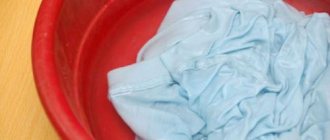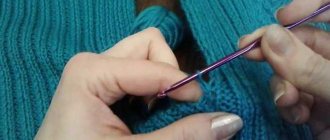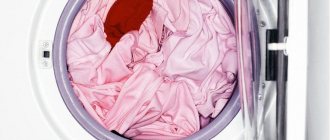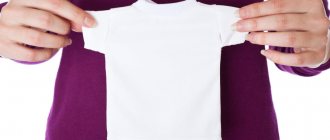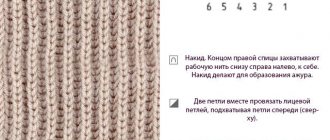Taking your husband's faded shirt or favorite dress out of the washing machine is extremely unpleasant. This happens unexpectedly, often even when washing rules are followed. No one is immune from low-quality dyes that can ruin clothes. Some housewives believe that in this case the product cannot be restored, but it is still possible to wash a faded item. What methods and means exist that allow you to return a piece of clothing to its original appearance, we will consider in our article.
Every housewife can face the problem of faded things.
How to find out if something might fade
Pay attention to one detail when buying a new item: it comes with a piece of cloth. Before washing, do a simple test on it.
If there is no such piece, test the hem from the wrong side.
Dye fastness test
How can you tell if the fabric is fading? Place the product in a bowl of warm water and soak. If after half an hour the water turns coloured, this will happen with every wash.
Moisten a cotton pad generously and rub the hem from the wrong side - if there is paint left on the cotton wool, the item will definitely fade.
What to do if the paint is unstable
If the item is dyed, wash it by hand and separately from others. Be sure to follow the instructions on the tag.
To fix the color, try pre-soaking in this solution.:
- In a bowl of water - 0.5 cups of salt and 0.5 cups of soda.
- Soak the item for 1 hour, rinse and wash as usual.
Advice: After washing, to fix the dye on the fabric, rinse the item with vinegar: 0.5 cups per basin. Just dry the fabrics in the fresh air so that the sour smell of vinegar disappears.
Why do clothes fade?
Who is to blame if the item fades after washing? There are many candidates: manufacturers of fabrics, clothing, washing machines, laundry detergents, the housewife herself. Purity of color disappears for several reasons.
- Gray, yellowish, brown, blue stains are formed from excess powder during washing.
- An incorrect washing mode results in dirt being smeared onto the fabric rather than being removed.
- Rust in the soaking container, washing machine or drying line.
- Washing colored laundry together with white.
- Printing, ink printing, or hand-painting on fabric may bleed if the water is too hot.
- During production, the paint on the fabric is weakly fixed or the fabric is saturated with it in excess. This often happens with jeans.
- When sewing clothes of combined colors, fabrics with different dyeing methods are combined.
- Decorative elements are made of low-quality materials and cannot be washed. Piping, cords, fabric buttons, and seam finishing with threads of contrasting colors sometimes create problems.
- Bad dye on some parts of clothing.
- Wrong choice of bleach or stain remover. If you pour bleach into the washing machine when washing, there is a possibility that you will end up with items that are the same dirty brown color.
- The washing temperature is high.
Before the first wash, a new item is briefly soaked in warm water with powder. It will be immediately obvious whether she sheds or not. This way, the quality of the dye and dyed fabric is checked without risking the rest of the clothing.
Brighteners and stain removers
The market offers many effective whiteners. These are “Whiteness” type products with active chlorine, as well as gentle oxygen stain removers. Some of them work in hot water, for example “Persol”, others also work at low temperatures, which means they are suitable for delicate care.
White
Soak white laundry in a bleach solution for 1-3 hours. For dense and natural cotton and linen, “Whiteness” is suitable.
Popular bleaches are produced by Eared Nanny, etc. Dilute them according to the instructions and soak things for 2-3 hours.
Colored
Special stain removers are suitable for colored fabrics. Look for bottles marked “for color” or “colour”.
The products are suitable for soaking and machine washing, and can be combined with powders.
Disadvantages of "Whiteness"
Users also noted some disadvantages of “Whiteness”:
- Negatively affects the fabric.
- Frequent use can lead to the destruction and change of the canvas itself, which wears out and breaks over time.
How to bleach faded items with this product? Using “Whiteness” it is prohibited to carry out bleaching procedures and remove stains on wool and silk. It is not recommended to pour/fill in when washing in a machine; chlorine damages parts of household appliances from the inside and leads to their breakdown. When using, you should follow safety precautions, first check for allergies and use very carefully.
Is it possible to bleach faded items using other compounds?
Let's consider another common good remedy - “Persol”. In structure, it is a powder that belongs to the oxygen type. It removes many different stains and can be used on almost any fabric.
Review of the best products
Based on the properties of the fabrics and their color, choose the appropriate home method and act immediately.
Stain remover + bleach + washing powder
Throw the still wet clothes with traces of paint back into the machine, this time excluding the faded items. Pour bleach or stain remover into the compartment, the product is selected according to the type of fabric. Start a new wash cycle.
Hydrogen peroxide
Washed and dyed laundry will be saved by hydrogen peroxide 3%. The product is suitable for all types of fabrics, including wool and silk products, swimwear, etc.
Soap the stains with laundry soap or Atipyatin, add 50 ml of peroxide to 4 liters of warm water. Place the item in the basin and wait 3-4 hours. Make sure that the fabric is completely immersed in the solution, otherwise streaks will appear.
Hydrogen peroxide + baking soda
Hydrogen peroxide acts as an oxygen bleach without damaging fabric fibers. In combination with soda, its effect is more noticeable. How to bleach white:
- Prepare a thick paste of baking soda and water and apply it to the stains.
- After half an hour, move the item into the peroxide solution and leave for several hours.
Boric acid
Effective bleach for delicate fabrics and underwear.
Works when things are soaked:
- Place a bottle of boric acid on a basin of water.
- Immerse things in the solution for a couple of hours.
The method is also effective for sun-bleached white clothes.
Citric acid + soap + starch + salt
Complex of stain removers:
- Mix potato starch, citric acid and salt in equal proportions.
- Add soap shavings (it’s better to use laundry soap).
- Make a warm solution and treat faded stains with it or soak the product completely.
- You can leave it overnight.
Ammonia
Ammonia will help correct washing errors. Works on white and color:
- For 10 liters of water - 25 ml of ammonia.
- Soak the item for at least half an hour.
- If the fabric is strong, use hot water.
- Wash as usual.
Baking soda
How to remove a stain with soda, two ways:
- Soak your clothes in a soda solution.
- Add some powder to the washing machine compartment and run the cycle.
Tip: Soda ash has the best whitening properties.
Vinegar
We use vinegar against traces of faded clothing:
- For 1 liter of water - 1 tbsp. l. vinegar 6-9%.
- Soak for 1 hour.
Whitening with aspirin
The pharmaceutical drug aspirin combats yellowness, grayness and traces of faded clothing. How to wash:
- Choose only pure aspirin, without vitamin supplements. An additional plus is that this drug is cheaper.
- Add a couple of crushed tablets to the powder.
- Wash the item by selecting the appropriate cycle.
Do not overuse the method if you bleach in a machine, as aspirin harms the parts of the device. If the method works for you, alternate between machine washing and soaking.
Washing with potassium permanganate
A rare but working method will restore the original white color:
- Prepare a weakly concentrated solution of potassium permanganate. The water should be slightly pink.
- Then lather the wet cloth well and immerse it in water.
- Leave for 3-4 hours.
Important: Only white can be saved; potassium permanganate is not used on colored ones.
Removing yellow stains from sweat
It is almost impossible to completely remove yellow stubborn sweat stains from white clothes. Such traces of organic matter are eaten into the fibers. Of course, if you treat the material with aggressive household chemicals, you can get rid of yellowness on clothes quite effectively, but in this case, most likely, your favorite item will also be damaged.
The only effective way to prevent permanent yellow stains from appearing on clothes is to wash them after each use. You should also, if possible, try to dry your laundry in direct sunlight, but this is not true for all fabrics.
Boiling
This radical method is only suitable for white and completely natural fabrics with a dense structure - cotton and linen.
They boil sheets, towels, sometimes clothes and linen:
- Add powder, soap shavings or bleach to cold water. Folk substitutes - hydrogen peroxide, ammonia, soda.
- Place the damaged item in the solution and only then heat it.
- Keep the bowl or pan over medium heat, stirring the item constantly.
- Boiling lasts 30-40, maximum 60 minutes. The water becomes cloudy in the process.
Avoid boiling clothes with elements such as embroidery, mesh, rhinestones, etc.
Preparing for washing
To avoid getting several damaged items after washing, the laundry must be prepared before the procedure. Sort all items by color, following the general rules:
- White items are washed separately from everything else.
- Dresses in warm shades such as pink, yellow and orange are loaded into one drum.
- Black and gray items are compatible.
- Green, purple and blue clothes are washed at the same time.
Expert opinion
Irina. Housewife.
Ask a Question
In addition, it is worth knowing that wool is processed separately from other fabrics in a special mode.
What to do if the item has faded and cannot be washed
Try redying your clothes if they are very dirty. There are special dyes for fabrics, as well as a number of traditional methods.
The most commonly used soaking is:
- in an infusion of onion peels or tea leaves (brown color);
- blue solution (blue, the best option for redying jeans);
- solution of pharmaceutical green;
- ink solution from a pen (to maintain black color);
- in berry and fruit juices and decoctions.
If the stain is small, try placing an adhesive patch over it. This move will only transform children's clothing.
As a last resort, go to a dry cleaner, they know how to deal with complex stains.
Step-by-step whitening instructions
- Pour clean water and boil.
- Throw shavings of laundry soap into boiling water; first rub.
- Drop and dissolve 15 peroxide tablets.
- Mix well.
- Leave the solution to cool and infuse.
- Then immerse things and bring to a boil.
- You need to “cook” the clothes for one to two hours as the stains are cleaned and more complex. Stir all the time with a wooden spatula.
- Then leave things in the solution until they cool down.
- Then put it in the bath and wash with conditioner.
Only cotton and linen can be washed this way.
How to prevent the situation from happening again
Returning fabrics to their original appearance is much more difficult than following simple care rules. Here are simple recommendations that every housewife should know by heart:
- Follow the recommendations on the label: do not wash in hot water if the 30 degree icon is set.
- Wash black with black, white with white, wool, denim and multi-colored laundry separately. Even different shades of black can affect each other, so a faded item should generally be washed separately.
- Do not neglect gels to protect colors - white, black, colored. Buy special anti-staining conditioners.
- Try not to buy dresses that are not durable.
- Do not mix different types of bleaches and stain removers to avoid trouble. It is better to alternate methods to achieve results.
If the color is not restored the first time, try another method or repeat the steps. In most cases, the situation is corrected by industrial or folk remedies, if you immediately tackle it.
Coloring
If no product helps or their use increases the risk of permanently ruining the faded item, you can use special dyes. Among the most famous and high-quality paints are Dylon, Simplicol and Rit. However, you need to remember that a good result can only be obtained when carrying out the procedure with natural tissues. Synthetics practically do not accept dyes into their fibers. This method can help not only neutralize color stains, but also renew the original color, making it brighter. In addition, unlike strong chemicals, paint does not destroy the structure of the fabric, does not deform the fibers and does not make them more vulnerable.
This method of getting rid of stains can also be used on white things. The only difference is that after the procedure it will also become colored.




